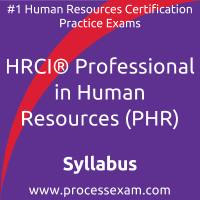|
Business Management |
- Using information about the organization and business environment to reinforce expectations, influence decision making, and avoid risk.
Responsibilities:
-
Interpret and apply information related to general business environment and industry best practices
-
Understand the role of cross-functional stakeholders in the organization and establish relationships for effective decision making (for example: org charts, span of control, shared services, centers of excellence)
-
Identify risks and recommend best practices (for example: compliance audit, mitigation, internal/external threats, safety, conflict of interest, employee relations, change management [automation, digitalization, gap analysis])
-
Understand metrics and interpret data to support business initiatives and recommend strategies (for example: attrition rates, diversity in hiring, time-to-hire, time-to-fill, ROI, success of training, promote continuous improvement using data)
-
Understand and reinforce organizational culture, core values, and ethical and behavioral expectations (for example: identify opportunities and make recommendations, contribute to diversity, equity, and inclusion [DEI], employer branding)
|
14% |
|
Workforce Planning and Talent Acquisition |
- Identifying, attracting, and employing talent while following all federal laws related to the hiring process.
Responsibilities:
-
Apply US federal laws and organizational policies to adhere to legal and ethical requirements in hiring (for example: Title VII, nepotism, disparate impact, FLSA, independent contractors)
-
Identify and implement sourcing methods and techniques to attract talent (for example: employee referrals, social media, diversity, equity, and inclusion [DEI] metrics, agencies, job boards, internal postings, job fairs, college recruitment, remote/hybrid work solutions)
-
Manage the talent acquisition lifecycle (for example: interviews, job offers, background checks, job descriptions, onboarding, orientation, assessment/skills exercises, employee integration)
|
14% |
|
Learning and Development |
- Contributing to the organization’s learning and development activities by implementing and evaluating programs, providing internal consultation, and providing data.
Responsibilities:
-
Implement and evaluate career development and training programs, including providing resources and guidance on professional growth and development opportunities (for example: career pathing, management training, mentorship, coaching, learning development plan)
-
Contribute to succession planning discussions with management by understanding and providing relevant data (for example: compensation, performance, turnover, exit surveys, attrition, evaluations, skills assessments, skills development resources)
-
Administer learning and development programs designed to achieve desired outcomes by the organization (for example: compliance, safety, benefits, HR systems and security, diversity, equity, and inclusion [DEI])
|
10% |
|
Total Rewards |
- Implementing, promoting, and managing compensation and benefit programs that attract and retain talent while complying with federal laws.
Responsibilities:
-
Manage and communicate total rewards programs to foster employee engagement and enhance employee experience (for example: compensation, payroll, recognition programs, incentives)
-
Implement and promote awareness of non-monetary rewards (for example: paid volunteer time, tuition assistance, workplace amenities, and employee recognition programs)
-
Implement benefit programs (for example: workplace amenities, flexible scheduling, remote/hybrid options)
-
Monitor and sustain US federally compliant compensation and benefit programs (for example: pay equity, benchmarking, salary bands, status changes, and life events)
|
15% |
|
Employee Engagement |
- Developing, communicating, and enhancing employee engagement initiatives to support optimal employee performance management activities throughout the employee lifecycle.
Responsibilities:
-
Measure and advise on functional effectiveness at each stage of the employee lifecycle and identify alternate approaches as needed (for example: hiring, onboarding, performance management, retention, exit process, alumni program)
-
Support the implementation and communication of organizational programs to enhance employee participation and engagement (for example: surveys, focus groups, welfare/wellness activities, employee resource groups [ERG], action plans from feedback)
-
Support the organization’s performance management strategy by completing appropriate steps in order to achieve organizational goals and objectives (for example: employee reviews, promotions, recognition programs)
-
Support performance and employment activities (for example: coaching, performance improvement plans, corrective actions, involuntary separations, job eliminations, reductions in force [RIF], offboarding)
|
17% |
|
Employee and Labor Relations |
- Manage, monitor, and/or promote legally compliant programs and policies that impact the employee experience.
Responsibilities:
-
Understand and apply knowledge of programs, US federal laws, and regulations to promote outreach, diversity, equity, and inclusion (DEI) (for example: affirmative action, employee resource groups [ERG], community outreach, corporate social responsibility [CSR])
-
Support workplace programs related to US federal health, safety, security, and privacy laws and regulations (for example: OSHA, workers’ compensation, emergency response, workplace violence, substance abuse, legal postings, documentation, investigations)
-
Provide interpretation and ensure compliance to organizational policies and procedures (for example: employee handbook, SOPs, time and attendance, expenses)
-
Process and support the resolution of employee complaints, concerns, or conflicts and escalate as needed (for example: investigate, document, initiate, recommend solutions, abide by grievance and ADR [alternative dispute resolution] procedures)
-
Promote techniques and tools for facilitating positive employee and labor relations with knowledge of US federal laws affecting union and nonunion workplaces (for example: anti-discrimination policies, harassment)
|
20% |
|
HR Information Management |
- Tools, technology, and systems that efficiently optimize the organization’s access to its human resource data.
Responsibilities:
-
Utilize and manage HR database content and technologies (for example: HRIS, maintain personnel data, employee status changes, salary changes)
-
Assess and communicate information obtained from HR databases (for example: generate reports, data analytics, identify trends)
-
Promote and maintain security best practices (for example: system access and permissions, front end user support, compliance, data integrity and data accuracy)
|
10% |
 To achieve the professional designation of HRCI Professional in Human Resources from the HRCI, candidates must clear the PHR Exam with the minimum cut-off score. For those who wish to pass the HRCI HR Professional certification exam with good percentage, please take a look at the following reference document detailing what should be included in HRCI HR Professional Exam preparation.
To achieve the professional designation of HRCI Professional in Human Resources from the HRCI, candidates must clear the PHR Exam with the minimum cut-off score. For those who wish to pass the HRCI HR Professional certification exam with good percentage, please take a look at the following reference document detailing what should be included in HRCI HR Professional Exam preparation.